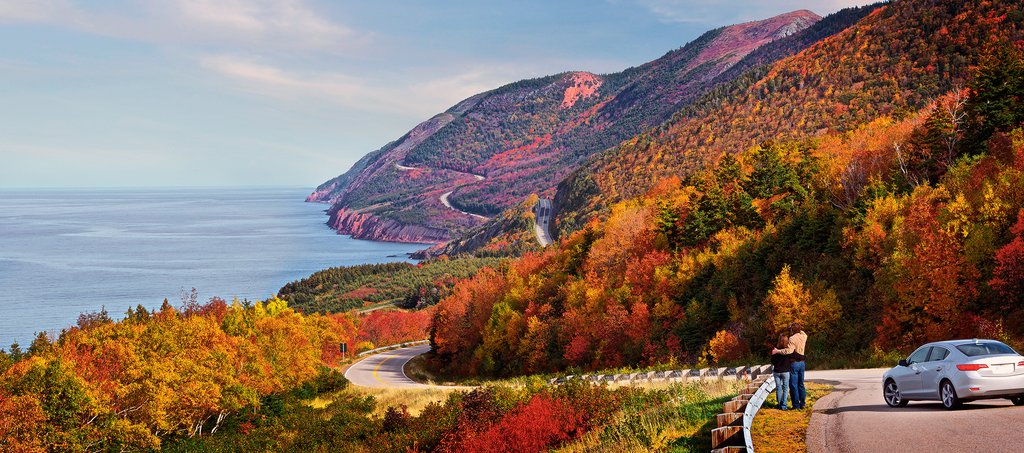We drove beautiful Cape Breton in mid-June, when the landscape was freshly green, lobster was in season, and roadsides were bursting with the purple spires of blossoming lupines. The highways were not yet crowded with summer tourists and the weather was wonderful. It was perfect.
A week isn’t enough time to squeeze in everything Cape Breton has to offer. If you’re into photography, hiking, golf, fly-fishing, crafts, hands-on history, sailing, or just solitary relaxation, you’ll find spots to your liking. And it’s heaven for those who love fresh seafood. Binding it all together is the infectious Celtic music that’s like the lifeblood of the island.
We began in Sydney because that’s the starting point for anyone arriving by air, ferry, or cruise ship. Connected to mainland Nova Scotia only by the Canso Causeway across the Strait of Canso, Cape Breton is very much an island, and one with a strong Celtic and Acadian heartbeat. Down at Sydney Harbour, a giant fiddle is hard to miss, as it towers 18 metres (60 ft.) high. An impressive site overlooking the waterfront park and its boardwalk promenade, the oversized instrument certainly conveys the importance of music in island life.
The nearby Governors Pub & Eatery and The Old Triangle Irish Alehouse are a couple of the places to catch live Celtic music. Happily, our room at the Cambridge Suites Hotel was within walking distance of both.
We squeezed into a table upstairs at the Governors just as the second set was beginning, with three fiddles, a banjo, Irish pipes, and a keyboard playing a rollicking jig. We weren’t there long before a local gent, Dennis Gillis, popped by the table and said, “I don’t recognize your face so you must be a CFA [come from away]…welcome!”
His was just the first of many local welcomes from folks around Cape Breton, surely some of the friendliest folks in all Canada.
CRAFTS AND CEILIDHS
Gillis told us that the first Scottish settlers were Highland Scots and that sometimes a whole village would emigrate together. In some small, isolated communities, Gaelic was spoken right up until the Second World War; many islanders remember their grandparents speaking it. Our first stop the next morning was at The Gaelic College in St. Ann’s to learn more. The Great Hall of the Clans, adorned with plaids and clan crests, is most impressive, and especially fascinating for those with Scottish ancestry.
Gaelic music in Cape Breton has remained pure and so close to its original Scottish roots that musicians come from Scotland to relearn the finer points of what has been lost. We were invited to join a “milling frolic.” Sitting with a dozen others around a long wooden table, we were taught to rhythmically pound a length of coarse material to soften it. The haunting rhythm of the tune we sang together to keep our hands working in unison stuck with us for hours after. Before we left, we stopped at the shop, a great spot to find all things Gaelic, including CDs of local musicians to provide our travelling music as we began our trip around the Cabot Trail.
In Sydney, we had popped into the Cape Breton Centre for Craft & Design on Charlotte Street and learned that many craftspeople have workshops and galleries along the North Shore of the Cabot Trail.
The first shop we discovered was Leather Works, where women in a workshop in the back were creating velvety-soft purses, wallets, and belts. Farther up the highway, a larger-than-life statue of a glass-blower caught our attention at the Glass Artisans Studio & Gallery.

PHOTO: PARKS CANADA
The garden was ablaze with twinkling, moving sculptures—entering the shop was like walking into a rainbow. In the workshop, we met Denise Burke, who has discovered a creative new use for our discontinued Canadian pennies: she melts glass enamel on pennies to create the unique Penny Art earrings sold around the island. We even found a pair made from pennies minted the year we were born.
Next door we admired the stunning wood craftsmanship of Bob Evans of North Shore Woodsmiths—and later discovered that the Clucking Hen restaurant across the road sells delicious sandwiches and desserts.
Auto touring is fun because you can turn off the main road whenever you want to explore. Our first spur-of-the-moment detour was to Little River. To our delight, we found a photogenic little wharf lined with fishing boats and stacks of lobster traps. All was quiet. A local named Jim explained that the lobster boats go out very early, around four in the morning, and are usually back and unloaded by noon.
Splendid views out over the ocean began to appear around many corners as the road climbed into the highlands of Cape Breton’s northern cape. That night, we checked into Castle Rock Country Inn near Ingonish Ferry, close to Cape Smokey. There we had our first of many memorable lobster dinners.
Later that evening, the sky seemed filled with a million stars as we gazed up from the inn’s balcony overlooking the sea. Free from the light pollution of cities, most of the Cabot Trail offers a magnificent dark-sky experience. The next morning at breakfast, we realized how close to nature we were when a moose wandered nonchalantly out of the woods.

PHOTO: PARKS CANADA
Back on the road, we sped past the popular fishing village of Ingonish and the entrance to venerable Keltic Lodge, with its challenging Highlands Links golf course. We entered Cape Breton Highlands National Park and, from its 26 hiking trails of varying lengths and degrees of difficulty, we chose Jack Pine Trail for our morning walk. Our favourite part of the trail was near the end overlooking Squeaker Hole, a bay where the sea rushes in, and the spot farther down the trail where one of Parks Canada’s Red Chairs offered a rest with a marvellous ocean view.
The most spectacular part of the Cabot Trail lay ahead as the highway rounded the northern tip of the island and headed back down the western coast. At the lookouts, we could glimpse the undulating road ahead winding its way along cliffs above the shimmering blue sea. Little wonder the 298-kilometre (185-mile) Cabot Trail has been voted among the top 10 most scenic drives in the world. Chatting at one of the lookouts with leather-clad members of an upscale motorcycle touring club from Vermont, we discovered that the Trail gets great reviews south of the border, too. The tourists told us their ride was living up to USA Today’s title of “The best motorcycle drive in the world!”
A colourful sign at Jean’s Gift Shop caught our eye as we entered the Acadian fishing village of Chéticamp: it read, proud to be hookers. Originally the hooked rugs of Chéticamp—wool hooked through a burlap backing—were made to warm the cold floors in winter, but today the local hookers create some of the most celebrated hooked art in North America and their work hangs on walls as art. Smaller pieces such as placemats, hot-pot mats, and pictures are for sale in this and many other local shops.
Needing a little refuelling for ourselves, we stopped for coffee at the Frog Pond Café farther into Chéticamp. As we browsed the adjoining gift shop for Gaelic music, we noticed that a number of CDs featured “Còig.” When we inquired, the shop owner explained that Còig is a group made up of solo island performers. Then he added, “Would you like to hear ’em? My son is a member and he’s practising with one of the others in our living room. Come on!”
With that, he led us out of his shop and into his house. His son, Jason, was just getting settled at the piano as Colin tuned his fiddle. We soon found ourselves in the middle of a lively kitchen party—a mini-ceilidh—as other folks followed the music into the house and furniture was moved aside for some step-dancing. Music seems so much a part of Cape Breton life that it just can’t help but bubble to the surface, and everyone joins in.
We drove down the highway to the sprightly music of Còig to locate our overnight at the luxurious Island Sunset cottages in Belle Cote. It was the perfect spot to relax and gaze out over the sea as the sun set on the Gulf of St. Lawrence.
GOLF AND WHISKY

Cabot Links opened five years ago, and Cabot Cliffs has been getting rave reviews since it opened in June of this year. Both are walking courses with spectacular panoramas from every hole. One golf reviewer called them “the very best links courses in North America, perhaps challenging the best in the world.”
We followed the road to Inverness Beach and joined locals that sunny afternoon walking the beach, searching for sea glass. Thanks to currents and tides, it’s the most likely spot to find the naturally created glass among the colourful beach stones. For a memorable keepsake, Brenda or Angela up the road at Tears of Glass jewellery design studio and gallery will fashion your sea glass into a necklace or bracelet.

From Glenville, we followed small, winding, country roads along the shore of Lake Ainslie, the largest inland lake in Nova Scotia. On this road less travelled, we passed farms, summer cottages, and summer trailer parks.
Our final stop on the Cabot Trail was the charming town of Baddeck, made famous by its illustrious summer resident Alexander Graham Bell. One could easily spend a day at the National Historic Site that bears his name.
Bell did so much more than invent the telephone: in the main exhibition hall hangs a full-size model of his experimental plane, the Silver Dart, the first plane to fly in Canada, in 1909. There are also models of his hydrofoil, tetrahedral kites, and many other inventions. A highlight for us was the “white-glove escorted tour” into the archives, where we were actually allowed to hold and read documents written by Bell. He wrote his wife daily and documented every single experiment, so there are volumes of material to document Bell’s life.
Down at Baddeck Harbour, we boarded the schooner Amoeba, which took us within view of the Bells’ summer estate, Beinn Bhreagh, perched on a headland above Bras d’Or Lake (much larger than Lake Ainslie, Bras d’Or Lake is in fact an inland sea and a mix of fresh and salt water). Hopefully the estate will one day be opened to the public.

PHOTO: NOVA SCOTIA TOURISM
On one of our final days, we paid a visit to the historic Fortress of Louisbourg, located about 45 minutes outside Sydney.
Louisbourg is the largest historical reconstruction in North America and accurate in detail thanks to historic blueprints from France.
The fortress was a strategic French presence in the New World. In 1744, it was the third-largest port on the Atlantic Coast of North America and epicentre of the immensely important French cod fishing industry. Inside the fortress gates, it’s as if you’ve stepped back 300 years.
There are soldiers in period French uniforms patrolling and drilling, ladies in bonnets and billowing gowns shopping, a jovial innkeeper offering a wee taste of Fortress rum, and an elegantly clad ship’s captain arranging to commandeer more crew. To see it all takes at least half a day or more.
We also explored the more recent history of Sydney.
We had our eyes opened to how rough a coal-mining life really was by touring the Miners Museum in Glace Bay, just a 30-minute drive east of Sydney. There you can tour underground—mostly crouched over, wearing a drip-protective poncho and hard hat—in what was a working mine. All the tour guides are former miners.
Our guide, Abbie Michalik, told us what it was like day in and day out, never seeing the sun, sometimes walking for kilometres under the ocean to get to your coal face. You got paid only for coal delivered to the surface, not for your time walking in, setting up equipment, or continuously testing for dangerous gases. On the other hand, you worked with family—Abbie told us that his father, grandfather, brother, and many uncles and cousins had all worked underground.
Today, the miners’ hard life is told in song by The Men of the Deeps, North America’s only coal miners’ chorus. The famous choir performs at the Miners Museum several Tuesdays during the summer, and a concert in October marks their 50th year.
FALL FESTIVAL
Our trip was at an end, but like others before us, we felt the lure to return. It will be in October, when the rocky splendour of Cape Breton is bathed in the burnished colours of fall and there is music everywhere.

PHOTO: CELTIC COLOURS
The annual Celtic Colours International Festival, now in its 20th year, will feature concerts by well-known Canadian musicians such as Natalie MacMaster and fiddler Donnell Leahy (her husband), Ashley MacIsaac, and Mary Jane Lamond. The festival is held annually for nine days in October near Thanksgiving.
This year, 49 concerts and more than 250 cultural events will be scattered across Cape Breton October 7–15. From the tiniest communities to the largest towns, music, dancing, storytelling, and art will fill every available public space. Come mid-October, Cape Breton will be a vibrant, colourful, musical place to be.
COVER PHOTO: DESTINATION CAPE BRETON ASSOCIATION
By Rob & Wendy Lindsay







